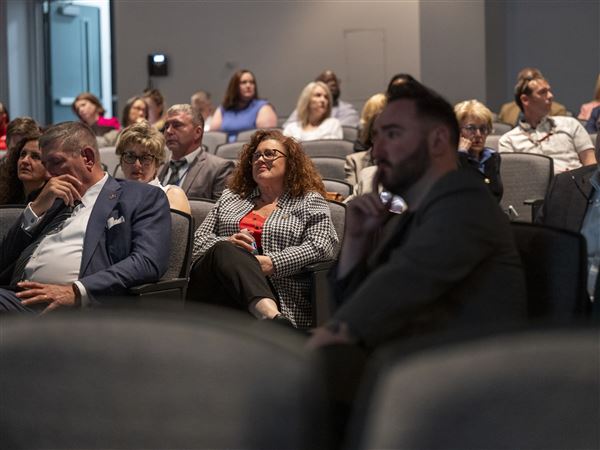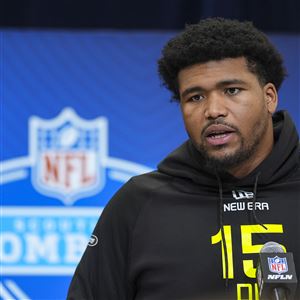
Steve Saint, center, with four Waodani tribesmen, three of whom helped to kill Mr. Saint's father and four other missionaries. Mr. Mincaye, second from left, killed the elder Saint, but later "adopted" young Mr. Saint, whose children call Mincaye "Grandfather."
Fifty years ago today, tribesmen in Ecuador speared five American missionaries.
The deaths of Peter Fleming, 27; Jim Elliot, 28; Ed McCully, 28; Roger Youderian, 31, and Nate Saint, 32, made headlines for weeks, and produced a bestseller. Fewer people know that their widows later led the killers to a Christian faith that ended generations of tribal revenge killings. That story is told in the movie "The End of the Spear," which opens Jan. 20.

Click photo for larger image.
The saga shaped generations of evangelical missionaries even as it prompted changes in their work. Steve Saint, 55, believes his slain father's legacy shows that ordinary people can serve extraordinary purposes.
"God isn't out recruiting superheroes," said Mr. Saint, who lives in Florida and was a consultant to the independent film.
"The distinction of the five men and the five women, who are even more heroic than the men, is simply that they cared about other people and were willing to give their lives so that other people could live."
The story was filmed largely from the tribe's viewpoint. They were once known as "Auca," a pejorative meaning "naked savages," coined by other tribes. Their own name, "true people," is rendered "Waodani" in the movie.
In 1959, Nate Saint's sister Rachel and Jim Elliot's widow, Elisabeth, made contact with the tribe. Rachel Saint remained with them for 30 years, and Steve Saint spent summers there from the age of 9. He was "adopted" by Mincaye, the man who had killed his father. After Rachel Saint's death in 1994, Mincaye asked him to help the tribe become less dependent on foreigners. The Indigenous-People's Technology and Education Center founded by Mr. Saint now adapts dentistry and other skills for non-industrial cultures.
It was his way to repay the tribe for tutelage when he joined it as a 9 year old. Mincaye scolded his aunt because the boy didn't know basic skills, such as how to make a blow gun.
"Aunt Rachel stuck her finger back at him and said, 'You, Mincaye, having killed his father -- who do you think should teach him how to live?" he recalled.
So Mincaye taught him while his aunt taught Christianity.
James Boster, an anthropologist from the University of Connecticut, studied the history of Waodani revenge murders, and concluded that Christian conversion prevented self-extinction. Deadly cycles of revenge had scattered them into small, paranoid factions. Attempted truces failed because their language had no words for abstractions such as "peace." Because Christianity was brought by kin of men they had killed, but who befriended them in return, it became a powerful way to signal commitment to nonviolence, he said.
From a dwindling 600 members in 1958, the tribe has grown to 2,000, he said.
The missionary deaths "really represent a kind of martyrdom in the best Christian sense," said Dr. Boster, who is not an evangelical Christian.
"At first blush, their death was needless, as they were there on a mission of peace. But, in the long run, the fact that their kin went back in peace to teach was a strong signal that the [Waodani] could trust both the messengers and the message."
Many people know the story from "Through Gates of Splendor," written by Mr. Elliot's widow, Elisabeth. It was virtually required reading for evangelical college students into the 1980s. Mr. Elliot's words as a Wheaton College senior in 1949 became a motto for generations of missionaries: "He is no fool to give up what he cannot keep to gain that which he cannot lose."
Kathryn Long, chairman of the history department at Wheaton, is writing a book that came from wondering what kept that story alive, while other missionaries were unsung martyrs.
One reason was that they epitomized post-World War II evangelicals, who rejected fundamentalist isolation and joined mainstream culture.
"In the narrative of their lives and deaths, the five Ecuador missionaries ... were captured in time as forever young, forever all-American, forever self-sacrificing and forever triumphant in their Christian commitment," she wrote.
But it took more than exemplary lives for their memory to endure.
"If you are going to be considered a martyr ... it helps to have gifted people to publicize your story," she said.
A missionary radio station in Ecuador issued bulletins as soon as the men were reported missing. U.S. journalists rushed that story home, where newspaper, radio and television audiences followed the search.
Life magazine photojournalist Cornell Capa made his way to the outpost where the wives of the murdered men had gathered. He was with them when they learned they were widows, and joined the dangerous trek to recover the bodies.
Mr. Capa, a nonobservant Jew, was so moved by the families that he continued to document them, and worked with the equally gifted Elisabeth Elliot on "Through Gates of Splendor." A bestseller in 1957, it was in print for 25 years, with anniversary editions in 1996.
The saga had a role in changing evangelical missions, partly due to Mrs. Elliot's writings, said Michael Hamilton, chairman of the history department at Seattle Pacific University. She denounced the tendency to demonize primitive cultures, and wrote of the virtue she found among the Waodani.
Above all, Dr. Hamilton said, the deaths signalled an end to evangelicals' naive assumption that they could bring the gospel and depart without unintended cultural consequences.
"Evangelicals started to have a much more sophisticated, anthropological view of other cultures," he said. Mission agencies became major employers of anthropologists.
The widows had resisted offers from Hollywood, believing that secular movie moguls would miss the spiritual meaning. That changed in 1997 when evangelical businessman Mart Green heard Mr. Saint and Mincaye speak. Mr. Green wanted to film the story from the tribe's viewpoint, and raised $20 million to do it. Mr. Saint was impressed that he traveled to the Ecuadoran jungle to ask the tribe's permission.
Dr. Long winced at fictional and conflated elements. But Mr. Saint says many details are accurate, and that the changes convey the larger truth..
The greatest fiction is a confrontation between the actor portraying him as an adult and the composite character Mincayani, who reveals that he killed Mr. Saint's father. The real Mr. Saint had long known who speared his father, and never wanted to kill the man who his own children now revere as "grandfather."
But the director "needed to show a point of reconciliation, and in a movie, it doesn't work to show a bunch of tiny little steps," he said.
When the movie fast-forwards 35 years, it glosses over great accomplishments and simmering controversies.
Rachel Saint devoted her life to the Waodani, but was so old-fashioned in her methods that her own mission agency forced her to leave for a time, Dr. Hamilton said. A polio epidemic shown on film happened later, and raised questions about whether fewer Waodani would have died if Miss Saint had allowed outside medical help sooner -- though she feared that an influx of outsiders might reignite the killings.
Although the missionaries appear as pacifists on film, they carried guns on the day of their fatal encounter. One tribesman later died of a gunshot wound, but it is unclear how he received it. The Waodani don clothes after their conversion in the film. According to Mr. Saint and Dr. Long, it was Dayuma, a woman who earlier escaped the tribe and became a Christian, who brought clothes to her people so they wouldn't be mocked as "naked savages."
"Aunt Rachel loved the Waodani. She loved the way they dressed or didn't dress. She loved the food they ate and the houses they built. She was absolutely in love with everything that was Waodani, except the killings."
Correction/Clarification: (Published Jan. 11, 2006) An article Sunday Jan. 8, 2006 about the murder of five missionaries in 1956 said that sociologist James Boster is not a Christian. It should have said that he is not an "evangelical Christian."
First Published: January 8, 2006, 5:00 a.m.















